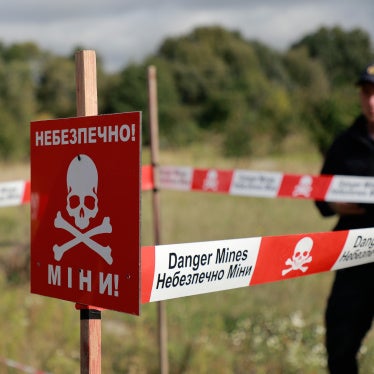(Bangkok) – The new treaty banning cluster bombs, which took effect just three months ago, has already made impressive strides in eradicating the weapon, Human Rights Watch said today. Seven countries have finished destroying their stockpiles of cluster munitions, two have cleared all contaminated land, and 10 have enacted national legislation to enforce the treaty.
The Convention on Cluster Munitions was negotiated in May 2008, opened for signature in December 2008, and, after achieving the required 30 ratifications, entered into force and became binding international law on August 1, 2010 – a very rapid pace for a multilateral agreement. A first report on progress to date, “Cluster Munition Monitor 2010,” was released on November 1 in Bangkok.
“We’ve made more progress, more quickly, than anyone thought possible just a few years ago,” said Steve Goose, Arms Division director at Human Rights Watch. “There is clearly a strong commitment to get rid of the weapon and to deal urgently with the ongoing threat to civilians.”
The Convention on Cluster Munitions prohibits the use, production, and transfer of cluster munitions, requires destruction of stockpiled cluster munitions within eight years and clearance of land contaminated by the weapon within 10 years, and provides for assistance to victims of cluster munitions.
A total of 108 nations have signed the convention, 43 of which have now ratified, becoming full states parties to the agreement. According to “Cluster Munition Monitor 2010,” 38 of the nations that have signed the convention are former users, producers, exporters, or stockpilers of the weapon.
The convention’s First Meeting of States Parties will be held in Vientiane, Laos from November 9-12. Laos is the country most severely affected by cluster munitions as a result of the US bombing campaign during the Vietnam War.
“Cluster Munition Monitor 2010” contains information about cluster munition policy and practice in every country of the world, including major powers that have not yet joined the convention such as Brazil, China, India, Israel, Pakistan, South Korea, Russia, and the United States.
“No nation should turn its back on this convention, the most important humanitarian and disarmament agreement of the past decade,” Goose said. “The inherent dangers to civilians far outweigh any limited military usefulness of cluster munitions.”
Cluster munitions were banned because of their indiscriminate impact at the time of use and the long-lasting danger they pose to civilians after use. These munitions, which can be fired by artillery and rocket systems or dropped by aircraft, typically explode in the air and spread dozens, even hundreds, of tiny submunitions over an area the size of a football field. In addition, submunitions often fail to explode on initial impact, leaving duds that act like landmines for months or years to come.
The Obama administration has not reviewed or altered the Bush administration policy, which commits the US not to use cluster munitions that have a failure rate of more than one percent, beginning at the end of 2018, in essence banning all but a tiny fraction of the existing arsenal. The US has not confirmed or denied a credible allegation that it used at least one cluster munition in Yemen in December 2009, which according to "Cluster Munition Monitor 2010" is the only reported use of cluster munitions worldwide in 2009 or 2010.
Other major findings in “Cluster Munition Monitor 2010” include:
•The seven countries that have already completed destruction of their stockpiles collectively destroyed more than 13.8 million submunitions contained in 176,000 cluster munitions. At least 11 other countries have started destroying their stocks.
•Over the past six decades cluster munitions have been used in 39 countries and areas by at least 18 governments.
•Fifteen former producers of cluster munitions have joined the convention, but 17 countries continue to produce, or reserve the right to produce, these weapons in the future.
•There were no recorded transfers of cluster munitions in 2009 or 2010, other than inert components from South Korea to Pakistan. Two countries that have not signed the treaty, the US and Singapore, have instituted a moratorium on exports of cluster munitions.
•At least 23 countries are affected by cluster munition contamination, including 14 that have joined the convention, as well as three disputed areas.
•At least 38 square kilometers of land were cleared of cluster munition remnants in 2009, with more than 55,156 unexploded submunitions destroyed.
•Albania and Zambia, both states parties to the treaty, have announced the completion of their clearance programs.
•By the end of 2009, 16,816 cluster munition casualties had been recorded in at least 27 states and three disputed areas, but due to significant underreporting, the actual number of cluster munition casualties might be as high as 85,000 worldwide.
•In 2009, there were 100 new confirmed cluster munition casualties in nine countries and one disputed area. Half of these casualties occurred in Laos and Lebanon, both of which have joined the convention.
“Cluster Munition Monitor 2010” is a product of the Nobel Peace Prize-winning International Campaign to Ban Landmines (ICBL) and of the Cluster Munition Coalition (CMC). Human Rights Watch is a founding member of both the ICBL and CMC. The Cluster Munition Monitor report is the sister publication to the Landmine Monitor report, which has been issued annually since 1999. The Landmine Monitor project was renamed Landmine and Cluster Munition Monitor in 2010.








